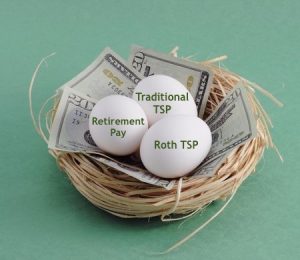Part 5 of The DoD Blended Retirement System: Leading up to the Decision
Article provided by FINRA Investor Education Foundation and SaveandInvest.org
 An increasing number of employers—including the federal government—now offer employees a choice between traditional or a Roth retirement savings options. With a Roth, employees are able to make after-tax contributions to their retirement savings account that will be tax-free when withdrawn.
An increasing number of employers—including the federal government—now offer employees a choice between traditional or a Roth retirement savings options. With a Roth, employees are able to make after-tax contributions to their retirement savings account that will be tax-free when withdrawn.
Comparing Your Options
Both the traditional TSP and Roth TSP feature tax-deferred compounding of contributions that are made to the account. However, tax treatment of contributions and withdrawals differ between the two options:
| Traditional TSP | Roth TSP | |
|---|---|---|
| Contributions | Come from pre-tax income, reducing gross income reported to IRS | Come from taxable income, not reducing gross income reported to IRS |
| Withdrawals | Taxed at your ordinary income tax rate | Tax-free, provided account is open at least five years and you are either at least 59½ or permanently disabled. In the event of death, withdrawals by heirs are tax-free. |
Considering Roth? It’s a Tax Decision
According to Thrift Savings Plan administrators, it is not easy to determine if the Roth TSP is right for you. Generally, Roth TSP might be a good fit for those who expect their tax rate to be higher in retirement than it is now. But it is not that simple.
When you make Roth contributions, there is no reduction in your adjusted gross income (as there is when you make traditional pre-tax contributions). This is an important factor in establishing your tax bracket and the tax deductions and credits that you can take. You should consider these factors as you decide on making Roth contributions. If you are in doubt, consult a qualified financial or tax advisor to be sure that you consider all the complexities of the tax law as they apply to your own situation.
Because it comes right out of your paycheck, a Roth contribution is likely to reduce your take home pay by more than a similar contribution to the traditional option, which is made using pre-tax dollars. If you want to save—and take home as much money as possible—allocating to the traditional TSP option could be the way to go.
Since you don’t pay federal or state income taxes on Roth withdrawals, the higher your tax bracket in retirement, the more advantageous a Roth is likely to be. Strong savers—including those who contribute the maximum amount allowed by the IRS each year—are good Roth candidates because they are likely to have a bigger nest egg in retirement that can benefit from Roth’s tax-free withdrawals.
On the other hand, if you’re in a low tax bracket today, you might consider a Roth now, when a lowering of your gross income will not be as significant a tax benefit as it might be later on, if you find yourself in a higher bracket.
Finally, since no one knows what tax rates will be in the future, diversifying with contributions to both a traditional and Roth TSP account might be a way to hedge your tax bets with your retirement savings.
Roth TSP and Roth IRAs
Roth TSP contributions do not count toward the limits on Roth IRA contributions. This just means that if you are eligible to contribute to a Roth IRA, making Roth TSP contributions won’t lessen the amount that you can contribute to a Roth IRA. On the other hand, it’s possible that making Roth TSP contributions may make you ineligible for a Roth IRA. That’s because your Roth contributions are counted as part of your adjusted gross income (AGI), while your traditional pre-tax contributions are not. Your AGI will be higher if you make Roth contributions than it would be if you made traditional contributions of the same amount. This is just one of the factors you will need to keep in mind as you evaluate Roth TSP.
Tax treatments aside, both the traditional and Roth TSPs require minimum distributions after you turn 70½ in most cases. In addition, both can be rolled over to an IRA or other retirement savings plans such as a 403(b) or when you retire or leave your job for any reason.
Your total contribution can’t be more than the annual limit the IRS sets for an employer-sponsored retirement plan. With an employer-sponsored Roth, as well as a traditional option, there are no income restrictions limiting who can participate. The only requirement is eligibility to participate in your employer’s plan.
Roth TSP and Required Minimum Distributions (RMDs)
The year after you turn age 70½, the IRS requires you to begin receiving a minimum amount of money from your account (unless you are still working). This is your RMD, and it is calculated based on your account balance and IRS life expectancy tables. IRS requirements for RMDs apply to employer-sponsored retirement plans like the TSP with no exceptions; therefore, RMDs will apply to Roth money in your TSP account, even though they do not apply to Roth IRAs.
To learn more about the TSP’s Roth option, visit the TSP website: www.tsp.gov.